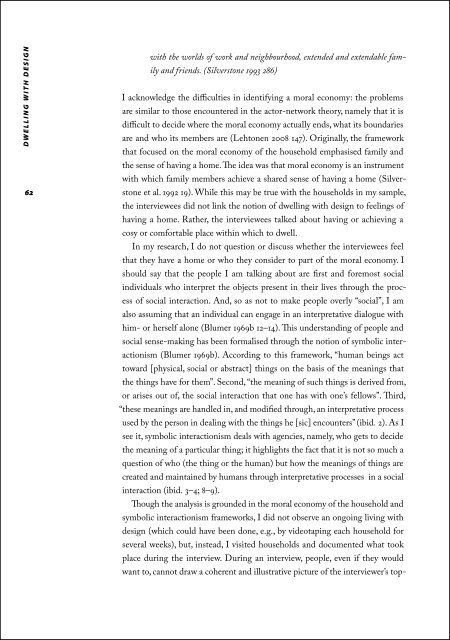Lataa ilmaiseksi
Lataa ilmaiseksi
Lataa ilmaiseksi
Create successful ePaper yourself
Turn your PDF publications into a flip-book with our unique Google optimized e-Paper software.
D W E L L I N G W I T H D E S I G N<br />
62<br />
with the worlds of work and neighbourhood, extended and extendable family<br />
and friends. (Silverstone 1993 286)<br />
I acknowledge the difficulties in identifying a moral economy: the problems<br />
are similar to those encountered in the actor-network theory, namely that it is<br />
difficult to decide where the moral economy actually ends, what its boundaries<br />
are and who its members are (Lehtonen 2008 147). Originally, the framework<br />
that focused on the moral economy of the household emphasised family and<br />
the sense of having a home. The idea was that moral economy is an instrument<br />
with which family members achieve a shared sense of having a home (Silverstone<br />
et al. 1992 19). While this may be true with the households in my sample,<br />
the interviewees did not link the notion of dwelling with design to feelings of<br />
having a home. Rather, the interviewees talked about having or achieving a<br />
cosy or comfortable place within which to dwell.<br />
In my research, I do not question or discuss whether the interviewees feel<br />
that they have a home or who they consider to part of the moral economy. I<br />
should say that the people I am talking about are first and foremost social<br />
individuals who interpret the objects present in their lives through the process<br />
of social interaction. And, so as not to make people overly “social”, I am<br />
also assuming that an individual can engage in an interpretative dialogue with<br />
him- or herself alone (Blumer 1969b 12–14). This understanding of people and<br />
social sense-making has been formalised through the notion of symbolic interactionism<br />
(Blumer 1969b). According to this framework, “human beings act<br />
toward [physical, social or abstract] things on the basis of the meanings that<br />
the things have for them”. Second, “the meaning of such things is derived from,<br />
or arises out of, the social interaction that one has with one’s fellows”. Third,<br />
“these meanings are handled in, and modified through, an interpretative process<br />
used by the person in dealing with the things he [sic] encounters” (ibid. 2). As I<br />
see it, symbolic interactionism deals with agencies, namely, who gets to decide<br />
the meaning of a particular thing; it highlights the fact that it is not so much a<br />
question of who (the thing or the human) but how the meanings of things are<br />
created and maintained by humans through interpretative processes in a social<br />
interaction (ibid. 3–4; 8–9).<br />
Though the analysis is grounded in the moral economy of the household and<br />
symbolic interactionism frameworks, I did not observe an ongoing living with<br />
design (which could have been done, e.g., by videotaping each household for<br />
several weeks), but, instead, I visited households and documented what took<br />
place during the interview. During an interview, people, even if they would<br />
want to, cannot draw a coherent and illustrative picture of the interviewer’s top-
















